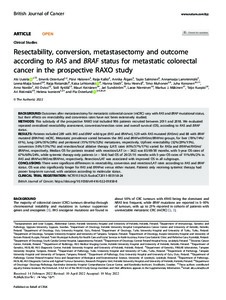Resectability, conversion, metastasectomy and outcome according to RAS and BRAF status for metastatic colorectal cancer in the prospective RAXO study
Uutela Aki; Osterlund Emerik; Halonen Päivi; Kallio Raija; Ålgars Annika; Salminen Tapio; Lamminmäki Annamarja; Soveri Leena-Maija; Ristamäki Raija; Lehtomäki Kaisa; Stedt Hanna; Heervä Eetu; Muhonen Timo; Kononen Juha; Nordin Arno; Ovissi Ali; Kytölä Soili; Keinänen Mauri; Sundström Jari; Nieminen Lasse; Mäkinen Markus J.; Kuopio Teijo; Ristimäki Ari; Isoniemi Helena; Osterlund Pia
https://urn.fi/URN:NBN:fi-fe2022081154825
Tiivistelmä
Background
Outcomes after metastasectomy for metastatic colorectal cancer (mCRC) vary with RAS and BRAF mutational status, but their effects on resectability and conversion rates have not been extensively studied.
Methods
This substudy of the prospective RAXO trial included 906 patients recruited between 2011 and 2018. We evaluated repeated centralised resectability assessment, conversion/resection rates and overall survival (OS), according to RAS and BRAF status.
Results
Patients included 289 with RAS and BRAF wild-type (RAS and BRAFwt), 529 with RAS mutated (RASmt) and 88 with BRAF mutated (BRAFmt) mCRC. Metastatic prevalence varied between the RAS and BRAFwt/RASmt/BRAFmt groups, for liver (78%/74%/61%), lung (24%/35%/28%) and peritoneal (15%/15%/32%) metastases, respectively. Upfront resectability (32%/29%/15%), conversion (16%/13%/7%) and resection/local ablative therapy (LAT) rates (45%/37%/17%) varied for RASa and BRAFwt/RASmt/BRAFmt, respectively. Median OS for patients treated with resection/LAT (n = 342) was 83/69/30 months, with 5-year OS-rates of 67%/60%/24%, while systemic therapy-only patients (n = 564) had OS of 29/21/15 months with 5-year OS-rates of 11%/6%/2% in RAS and BRAFwt/RASmt/BRAFmt, respectively. Resection/LAT was associated with improved OS in all subgroups.
Conclusions
There were significant differences in resectability, conversion and resection/LAT rates according to RAS and BRAF status. OS was also significantly longer for RAS and BRAFwt versus either mutant. Patients only receiving systemic therapy had poorer long-term survival, with variation according to molecular status.
Kokoelmat
- Rinnakkaistallenteet [27094]
